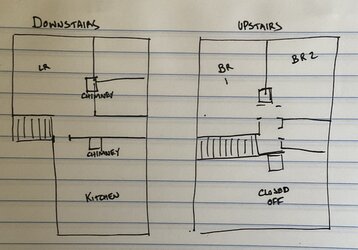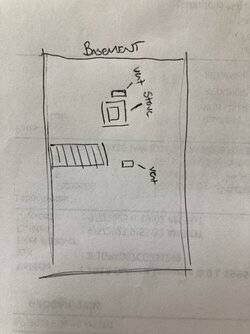Hi! Apologies in advance for the long post. I've really enjoyed reading the forums here but am having some trouble figuring things out as a beginner, so I thought I'd ask directly for thoughts about our particular situation. My partner and I moved into his childhood home when his mother unexpectedly passed away last year. The house is a two story farmhouse with a gravel basement, built in the mid 19th c. We're on the border between VT and MA up in the hills; we don't usually have negative winter temps, coldest nights in the single digits but a relatively long winter and cold season. Last winter we bought seasoned oak from a local guy, and towards the spring supplemented with what we cut ourselves. This year we're planning to use mostly what we cut last spring. The house needs a lot of work which we've been slowly doing as we can afford it, but last year it was really hard to keep warm consistently and we're trying to figure out what changes to make to the current setup.
House: The first story is ~1000 sq feet with 8 foot ceilings, divided into two large rooms (kitchen and living room) plus a small bathroom and office. The kitchen is open to the living room but the opening is narrow, about the width of a regular doorframe. A staircase in the living room leads to the second floor, where there are two bedrooms and a bathroom totaling ~600 sq feet, 8 foot ceilings. There is an additional 400 sq. foot space upstairs with lower slanted ceilings (converted attic) which is currently used as an office with the door shut, and has its own thermostat//is heated with propane. We had an energy auditor come out recently and he said that the walls had decent insulation for an older house. We're planning on putting more in the attic soon. I've attached a quick sketch of our layout.
Current heat setup:
1) Enerzone Solution 2.9 in the basement (BTU rating 85k), with a blower, installed 2013. No complaints about the stove itself except that most of the heat stays down there--basement can be 80 degrees and the rest of the house can't manage to get above 60, even in pretty mild temps. There are two floor vents but they don't really pass any heat upstairs.
2) Avalon Rainer 945 in the kitchen, installed in 2011 (BTU rating 71K). It fires *very* hot and burns out quickly; the heat it puts out stays in the kitchen, so if we run it the kitchen can jump to 78 degrees and the living room is still pretty cold--it's hard to get it to run for a longer time on a slower burn. It looks like my mother-in-law likely overfired it and we suspect that there are some issues with the baffle and possibly the inlet valve damper. She routinely burned 10 cords of wood over the course of a winter in addition to running the propane, which seems crazy to us.
3) Propane backup currently; we're looking into possibility of replacing with heat pumps since our state has good incentives. Had some bad encounters with the company last winter (the tech left a valve open, there was a leak and we lost 25% of the tanks in under 24 hours, fire dept had to come, company repeatedly denied anything was wrong) and we're keen to move away from propane if we can.
Since the house doesn't have a good built-in way to transfer heat from the basement, we're thinking about either taking out the Enerzone and moving it up to the living room (where its chimney comes up) or buying a different woodstove to go there; the original family who built the house had a fireplace in that room, and it seems like a more sensible place for a radiant heat source than the basement since the stairs to the upper level are in that room. We're also thinking about eventually replacing the kitchen stove with something more functional and efficient, but since that stove only really heats the kitchen it's less of a priority than figuring out the main stove. I wasn't familiar with cat converter types (BK etc) until recently but have been reading about them, and a Swedish friend has suggested looking into a heat mass/masonry stove. I'm not sure whether either of those directions would be a good fit for our space, if we should try and find a better conventional stove (Jotul?), or simply move the downstairs stove upstairs. I talked to a local stove dealer yesterday but their reviews aren't the best and I found myself not completely trusting what they were saying.
An ideal house temperature for us would be in the 65-67 range but that's been very hard to achieve with the current setup---last year it was difficult to get above 59 in any room but the kitchen and basement, even with both stoves going. We ran some fans to try and move air around but they didn't help much. We're open to keeping our current stoves and revising our approach or their location, but with the tax credits this seems like a good moment to possibly jump to something more efficient and cleaner burning that could also keep the house at a reasonable temp.
Grateful for any advice.

House: The first story is ~1000 sq feet with 8 foot ceilings, divided into two large rooms (kitchen and living room) plus a small bathroom and office. The kitchen is open to the living room but the opening is narrow, about the width of a regular doorframe. A staircase in the living room leads to the second floor, where there are two bedrooms and a bathroom totaling ~600 sq feet, 8 foot ceilings. There is an additional 400 sq. foot space upstairs with lower slanted ceilings (converted attic) which is currently used as an office with the door shut, and has its own thermostat//is heated with propane. We had an energy auditor come out recently and he said that the walls had decent insulation for an older house. We're planning on putting more in the attic soon. I've attached a quick sketch of our layout.
Current heat setup:
1) Enerzone Solution 2.9 in the basement (BTU rating 85k), with a blower, installed 2013. No complaints about the stove itself except that most of the heat stays down there--basement can be 80 degrees and the rest of the house can't manage to get above 60, even in pretty mild temps. There are two floor vents but they don't really pass any heat upstairs.
2) Avalon Rainer 945 in the kitchen, installed in 2011 (BTU rating 71K). It fires *very* hot and burns out quickly; the heat it puts out stays in the kitchen, so if we run it the kitchen can jump to 78 degrees and the living room is still pretty cold--it's hard to get it to run for a longer time on a slower burn. It looks like my mother-in-law likely overfired it and we suspect that there are some issues with the baffle and possibly the inlet valve damper. She routinely burned 10 cords of wood over the course of a winter in addition to running the propane, which seems crazy to us.
3) Propane backup currently; we're looking into possibility of replacing with heat pumps since our state has good incentives. Had some bad encounters with the company last winter (the tech left a valve open, there was a leak and we lost 25% of the tanks in under 24 hours, fire dept had to come, company repeatedly denied anything was wrong) and we're keen to move away from propane if we can.
Since the house doesn't have a good built-in way to transfer heat from the basement, we're thinking about either taking out the Enerzone and moving it up to the living room (where its chimney comes up) or buying a different woodstove to go there; the original family who built the house had a fireplace in that room, and it seems like a more sensible place for a radiant heat source than the basement since the stairs to the upper level are in that room. We're also thinking about eventually replacing the kitchen stove with something more functional and efficient, but since that stove only really heats the kitchen it's less of a priority than figuring out the main stove. I wasn't familiar with cat converter types (BK etc) until recently but have been reading about them, and a Swedish friend has suggested looking into a heat mass/masonry stove. I'm not sure whether either of those directions would be a good fit for our space, if we should try and find a better conventional stove (Jotul?), or simply move the downstairs stove upstairs. I talked to a local stove dealer yesterday but their reviews aren't the best and I found myself not completely trusting what they were saying.
An ideal house temperature for us would be in the 65-67 range but that's been very hard to achieve with the current setup---last year it was difficult to get above 59 in any room but the kitchen and basement, even with both stoves going. We ran some fans to try and move air around but they didn't help much. We're open to keeping our current stoves and revising our approach or their location, but with the tax credits this seems like a good moment to possibly jump to something more efficient and cleaner burning that could also keep the house at a reasonable temp.
Grateful for any advice.



